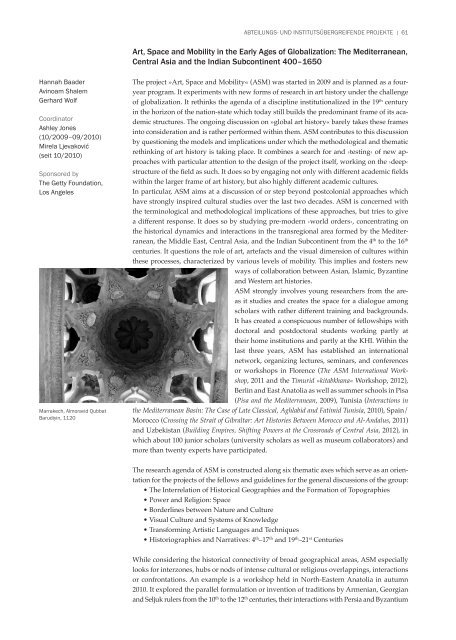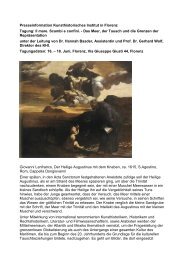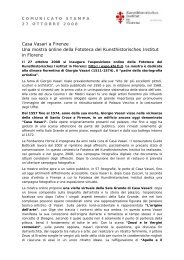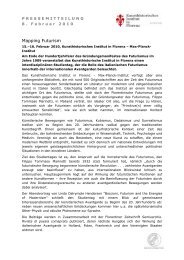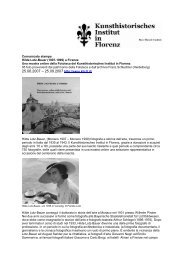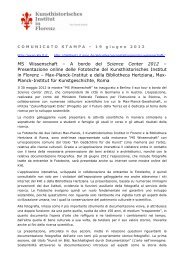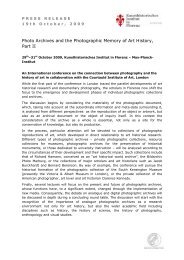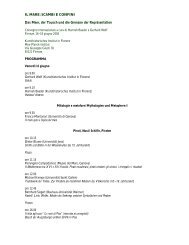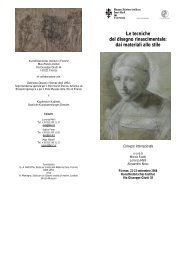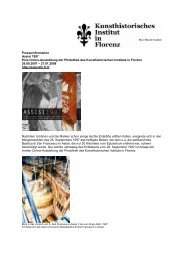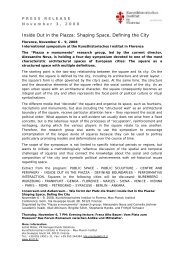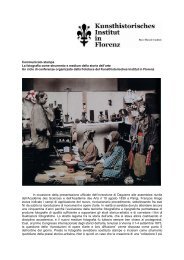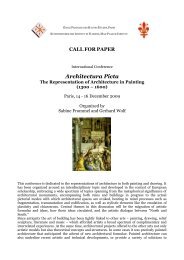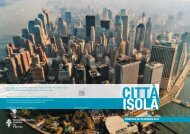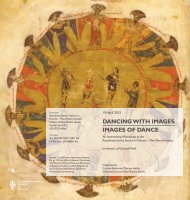forschungsbericht november 2008 – juli 2012 - Kunsthistorisches ...
forschungsbericht november 2008 – juli 2012 - Kunsthistorisches ...
forschungsbericht november 2008 – juli 2012 - Kunsthistorisches ...
Erfolgreiche ePaper selbst erstellen
Machen Sie aus Ihren PDF Publikationen ein blätterbares Flipbook mit unserer einzigartigen Google optimierten e-Paper Software.
ABTEILUNGS- UND INSTITUTSÜBERGREIFENDE PROJEKTE | 61<br />
Art, Space and Mobility in the Early Ages of Globalization: The Mediterranean,<br />
Central Asia and the Indian Subcontinent 400<strong>–</strong>1650<br />
Hannah Baader<br />
Avinoam Shalem<br />
Gerhard Wolf<br />
Coordinator<br />
Ashley Jones<br />
(10/2009<strong>–</strong>09/2010)<br />
Mirela Ljevaković<br />
(seit 10/2010)<br />
Sponsored by<br />
The Getty Foundation,<br />
Los Angeles<br />
Marrakech, Almoravid Qubbat<br />
Barudiyin, 1120<br />
The project »Art, Space and Mobility« (ASM) was started in 2009 and is planned as a fouryear<br />
program. It experiments with new forms of research in art history under the challenge<br />
of globalization. It rethinks the agenda of a discipline institutionalized in the 19 th century<br />
in the horizon of the nation-state which today still builds the predominant frame of its academic<br />
structures. The ongoing discussion on »global art history« barely takes these frames<br />
into consideration and is rather performed within them. ASM contributes to this discussion<br />
by questioning the models and implications under which the methodological and thematic<br />
rethinking of art history is taking place. It combines a search for and ›testing‹ of new approaches<br />
with particular attention to the design of the project itself, working on the ›deep‹<br />
structure of the field as such. It does so by engaging not only with different academic fields<br />
within the larger frame of art history, but also highly different academic cultures.<br />
In particular, ASM aims at a discussion of or step beyond postcolonial approaches which<br />
have strongly inspired cultural studies over the last two decades. ASM is concerned with<br />
the terminological and methodological implications of these approaches, but tries to give<br />
a different response. It does so by studying pre-modern ›world orders‹, concentrating on<br />
the historical dynamics and interactions in the transregional area formed by the Mediterranean,<br />
the Middle East, Central Asia, and the Indian Subcontinent from the 4 th to the 16 th<br />
centuries. It questions the role of art, artefacts and the visual dimension of cultures within<br />
these processes, characterized by various levels of mobility. This implies and fosters new<br />
ways of collaboration between Asian, Islamic, Byzantine<br />
and Western art histories.<br />
ASM strongly involves young researchers from the areas<br />
it studies and creates the space for a dialogue among<br />
scholars with rather different training and backgrounds.<br />
It has created a conspicuous number of fellowships with<br />
doctoral and postdoctoral students working partly at<br />
their home institutions and partly at the KHI. Within the<br />
last three years, ASM has established an international<br />
network, organizing lectures, seminars, and conferences<br />
or workshops in Florence (The ASM International Workshop,<br />
2011 and the Timurid »kitabkhana« Workshop, <strong>2012</strong>),<br />
Berlin and East Anatolia as well as summer schools in Pisa<br />
(Pisa and the Mediterranean, 2009), Tunisia (Interactions in<br />
the Mediterranean Basin: The Case of Late Classical, Aghlabid and Fatimid Tunisia, 2010), Spain/<br />
Morocco (Crossing the Strait of Gibraltar: Art Histories Between Morocco and Al-Andalus, 2011)<br />
and Uzbekistan (Building Empires, Shifting Powers at the Crossroads of Central Asia, <strong>2012</strong>), in<br />
which about 100 junior scholars (university scholars as well as museum collaborators) and<br />
more than twenty experts have participated.<br />
The research agenda of ASM is constructed along six thematic axes which serve as an orientation<br />
for the projects of the fellows and guidelines for the general discussions of the group:<br />
• The Interrelation of Historical Geographies and the Formation of Topographies<br />
• Power and Religion: Space<br />
• Borderlines between Nature and Culture<br />
• Visual Culture and Systems of Knowledge<br />
• Transforming Artistic Languages and Techniques<br />
• Historiographies and Narratives: 4 th <strong>–</strong>17 th and 19 th <strong>–</strong>21 st Centuries<br />
While considering the historical connectivity of broad geographical areas, ASM especially<br />
looks for interzones, hubs or nods of intense cultural or religious overlappings, interactions<br />
or confrontations. An example is a workshop held in North-Eastern Anatolia in autumn<br />
2010. It explored the parallel formulation or invention of traditions by Armenian, Georgian<br />
and Seljuk rulers from the 10 th to the 12 th centuries, their interactions with Persia and Byzantium


